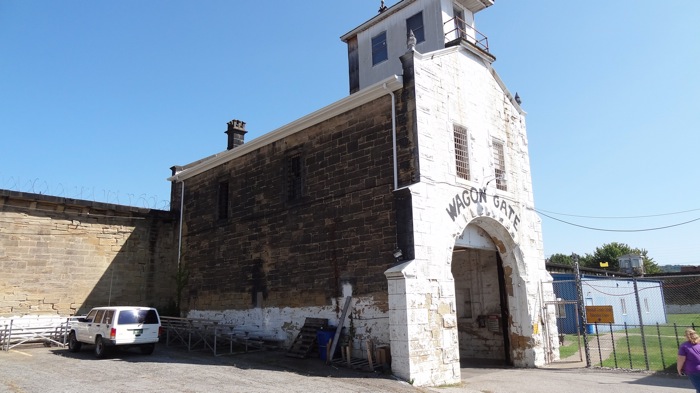We were cruising the back roads around Avella, west of Washington PA, when we stopped at a pull-in to stretch our legs and enjoy the waters of a small stream we'd spotted. As we walked down to the stream we spotted someone we thought was paddling. As we got closer we saw that he was in fact, a Native American.
 |
He didn't know we were there at first.
|
We'd heard about this tribe, the Shysoo. They've managed to avoid all contact with settlers up to the present day, helped by a little known Act of Congress passed in 1974, banning all contact between US citizens and the natives. To see one is a very rare event.
 |
He told us to go away at first.
|
They live in the densely wooded hills of South West Pennsylvania and the North of West Virginia - the Mountain State. They still live their old way of live, totally uncontaminated by modern American culture.
 |
He could see we were impressed with his method of catching fish.
|
When he spotted us, he obviously wanted to disappear into the forest, but that would have meant leaving the fish he'd caught behind. He was using the ancient technique of poisoning them with the juice from crushed walnuts washed into the water. It seemed very effective, even working on the crayfish under the stones.
 |
He showed us how he made a fishing line from sinew.
|
As we're not American, we figured we could approach him. We managed to convince him we were friendly, by offering him some Pecan Butter ice cream from our freezer on the RV. Then we discovered he spoke a form of Shysoo. This meant we could understand him better than most of the modern Americans we meet.
 |
Some Crayfish he'd caught. We told him they wouldn't go well with the ice cream.
|
We told him we were from New Zealand, as we didn't want to get him angry about all those broken British treaties; after all, he had a stone axe that looked rather fierce.
Because we weren't American, he agreed to take us to his village nearby and introduce us to some of this tribe. What an honour!
The first we met was his wife - we think. (We had difficulty understanding family references.)

|
His family were very surprised to see us!
|
She showed us how she made cord and what plants were useful for this purpose It was also amazing to see just how strong the tendons from a deer are; you can catch fish with it tied to a bone hook.
What also impressed us was how labour intensive the whole process of making cord was. But as she said;
"What else am I going to do at night? We don't have any TV in our huts, or McDonalds to go to." (I may have missed something in the translation.)
Then her neighbour showed us some bags and baskets she'd made. Apparently a lot of the detailing on the traditional Medicine Bag is made from porcupine quills. The bag is deep, so it can be hung over a belt without losing the contents.
She also showed us her corn platting that she used to make baskets to keep dry stuff in, but they're not very good when they get wet, as they rot easily. So she'd made a basket from very long pine needles that had been imported from the South. These can get wet with impunity, which is useful if you're draining the water out of an acorn cake.
 |
She was a cheerful soul who looked surprisingly like us.
|
Whilst all this was going on, one of the guys who'd been trapping animals came across to show us his latest triumph. He'd got the hide of a large red deer, and he was preparing it for treatment.
 |
He seemed happy in his job.
|
 |
I believe they also celebrate Haloween.
|
He handed it over to another even scarier chap who made a stone scraper whilst we watched. This was imported obsidian, which must have cost a fair amount of beaver skins. It was fascinating to see him create a sharp useable tool in the space of ten minutes. Then he got to work on the hide.
 |
After getting rid of most of the meat and fat...
|
 |
...he made a scraper while we watched. Fantastic!
|
We mooched around for a while, poking our noses into the huts, and seeing what was for dinner.
 |
The hut was very smoky - so they all lie down when at home.
|
They then showed us an old archeological site that had been opened up, called Meadowcroft. After much work digging, cataloguing, drawing and radio-carbon dating, this showed that this part of the world has been inhabited for the last 16,000 years.
 |
This is where their ancestors stopped for short holidays.
|
Our friend pointed out to us that if they'd just asked him, he could have told them all this and saved them a lot of bother.
 |
We promised to send them a photo - but later realised we didn't know where they'll be living.
|
We left them all with a tub of Peanut Brittle with Caramel Crunch ice cream. On reflection it may not have been a good idea…



































































